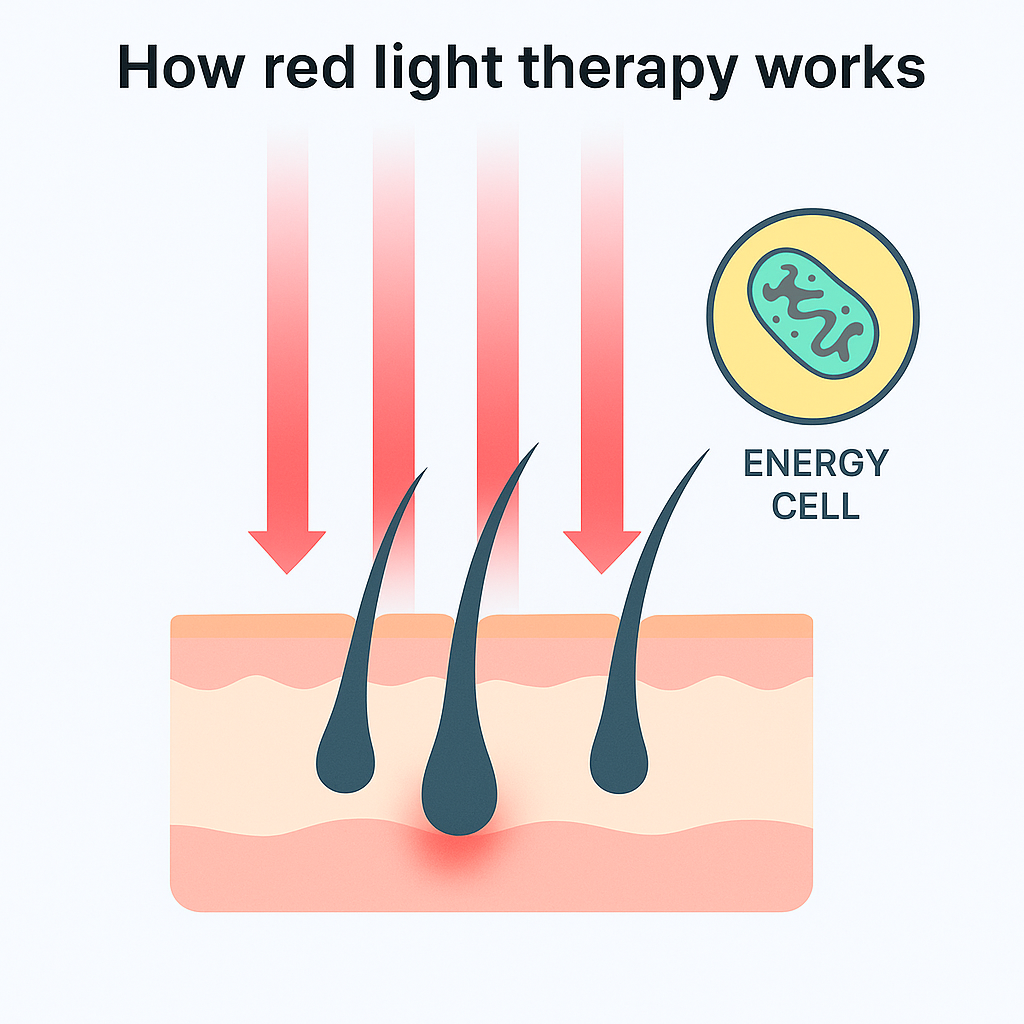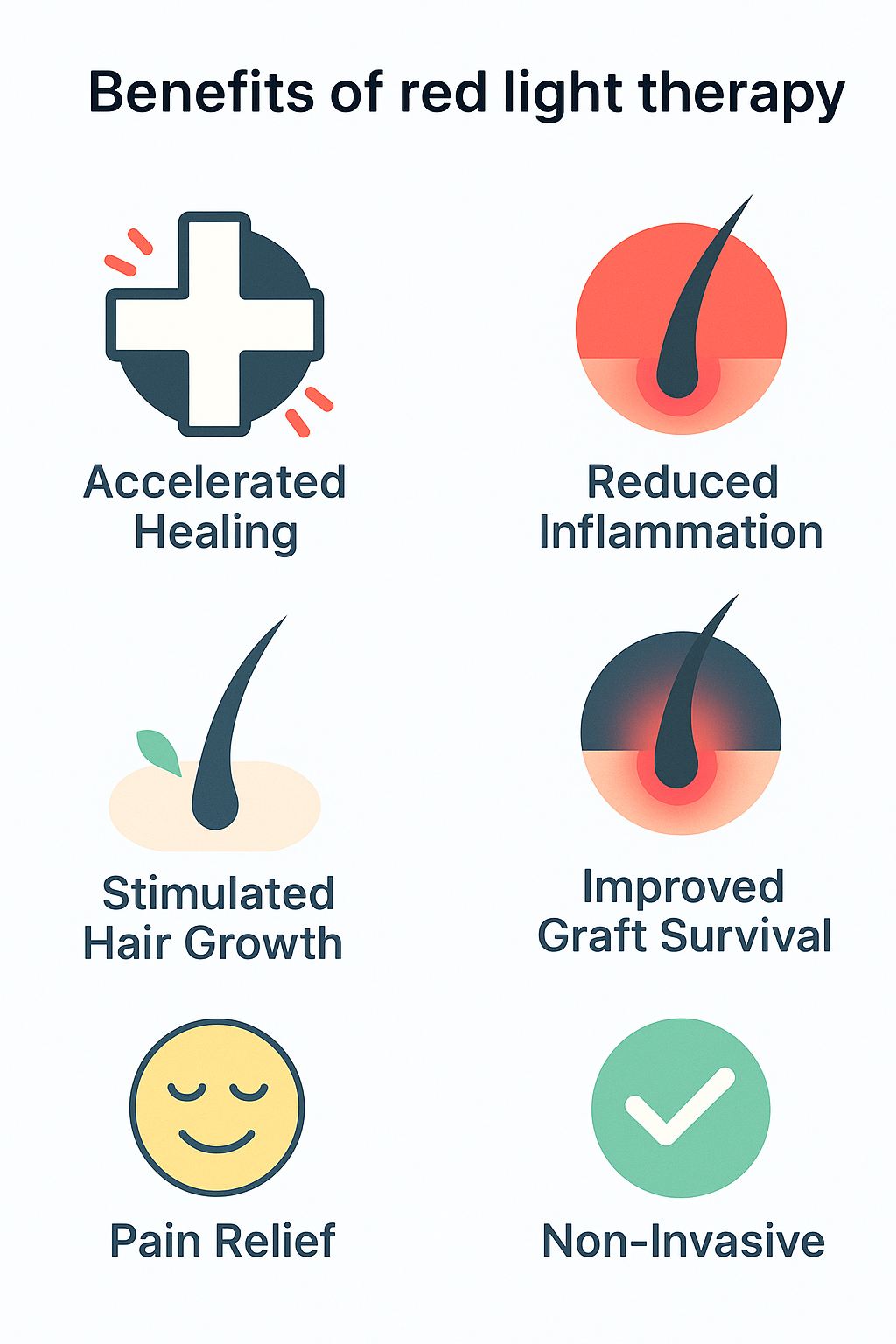Enhance your hair transplant results and accelerate healing with advanced red light therapy.
Red light therapy is a non-invasive treatment that uses low-level wavelengths of red light to stimulate hair follicles, accelerate healing, and improve the overall success of your hair transplant procedure.

Red Light Therapy (RLT), also known as Low-Level Laser Therapy (LLLT) or photobiomodulation, is a non-invasive treatment that uses specific wavelengths of red light to stimulate cellular function and promote healing.
The therapy works by delivering safe, concentrated wavelengths of natural light deep into your scalp tissue, where it's absorbed by the cells. This stimulates the mitochondria (the powerhouse of your cells) to generate more energy, resulting in increased cellular repair and regeneration.
For hair transplant patients, red light therapy can be particularly beneficial as it enhances the healing process, reduces inflammation, and stimulates newly transplanted hair follicles to grow healthier and stronger.


Red light wavelengths penetrate the scalp tissue and are absorbed by the cells. This stimulates the mitochondria to produce more ATP (energy), which powers cellular functions and regeneration.
The therapy increases microcirculation in the scalp, which improves oxygen and nutrient delivery to hair follicles while facilitating the removal of waste products.
Red light therapy awakens dormant hair follicles and extends the growth phase of the hair cycle, leading to thicker, longer, and healthier hair growth.
The timing for starting red light therapy after a hair transplant is crucial for optimal results. While every patient's recovery is unique, there are some general guidelines:
It's generally recommended to avoid red light therapy during the first week after your hair transplant. This allows the initial healing process to begin and the transplanted grafts to secure themselves in place.
Some surgeons may approve gentle red light therapy sessions starting 7-10 days after the procedure, once the initial scabs have begun to heal and the grafts are more secure.
Most patients can safely begin regular red light therapy sessions 2-3 weeks after their hair transplant procedure, when the risk of dislodging grafts is minimal.

Always follow your surgeon's specific recommendations regarding when to start red light therapy after your procedure. The timeline may vary based on your individual healing process and the specific technique used for your hair transplant.
For optimal results, red light therapy is typically recommended 2-3 times per week for at least 12-16 weeks after a hair transplant. Each session usually lasts between 15-30 minutes, depending on the device being used.
The most effective red light therapy for hair growth typically uses wavelengths between 630-670 nm (red light) and 810-850 nm (near-infrared light). These specific wavelengths have been shown to provide the greatest benefits for hair follicle stimulation.
While professional-grade red light therapy devices used in clinical settings are more powerful, there are also FDA-cleared devices available for at-home use. Your hair transplant surgeon can recommend the best option based on your specific needs and recovery progress.

For the best results, we recommend starting with in-clinic red light therapy sessions 2-3 weeks after your hair transplant, followed by a combination of professional treatments and at-home maintenance using approved devices. This comprehensive approach helps maximize graft survival and accelerate hair growth.
Numerous scientific studies have demonstrated the efficacy of red light therapy for hair growth and transplant recovery:
Several red light therapy devices have received FDA clearance for treating hair loss and promoting hair growth, confirming their safety and efficacy when used as directed. These devices are available in various forms, including helmets, caps, combs, and panels.
| Treatment | Mechanism | Benefits | Limitations |
|---|---|---|---|
| Red Light Therapy | Stimulates cellular energy production and blood flow | Non-invasive, painless, no side effects, promotes healing, improves graft survival | Requires multiple sessions, results may vary |
| PRP Therapy | Uses platelets from patient's blood to release growth factors | Promotes healing, improves graft survival, stimulates native hair growth | Minimally invasive, requires blood draw, some discomfort |
| Minoxidil | Vasodilator that increases blood flow to follicles | Topical application, may help native hair growth | Cannot be used immediately after transplant, daily application |
| Finasteride | Blocks DHT conversion to prevent further hair loss | Helps maintain native hair, prevents further loss | Oral medication, potential side effects, doesn't directly impact transplanted hair |
Yes, red light therapy is considered very safe when started at the appropriate time after a hair transplant (typically 2-3 weeks post-procedure). It is non-invasive, painless, and has no known side effects when used as directed.
For optimal results, we typically recommend using red light therapy for at least 12-16 weeks after your hair transplant, with 2-3 sessions per week. Many patients continue maintenance sessions even after this period to maximize long-term results.
No, when used properly, red light therapy doesn't damage transplanted hair. In fact, it helps improve graft survival and promotes healthier growth. However, it's important to follow your surgeon's guidelines on when to start treatment to avoid any potential disruption to newly transplanted grafts.
Yes, FDA-cleared at-home devices can be effective, though they typically have lower power output than professional-grade equipment. When used consistently according to instructions, they can provide significant benefits for hair growth and transplant recovery. We can recommend specific devices based on your needs.
Absolutely. Red light therapy works well in combination with other hair restoration treatments like PRP therapy and prescribed medications. In fact, a multi-therapy approach often yields the best results. Your treatment plan can be customized to your specific needs and goals.
Yes, red light therapy can help minimize and recover from shock loss (temporary shedding of existing hair that can occur after a transplant). It promotes faster recovery of these follicles and helps them return to the growth phase more quickly.
Schedule a consultation to learn how our customized red light therapy protocols can optimize your hair transplant recovery and results.
Adding red light therapy to my post-transplant care routine was one of the best decisions I made. My recovery was much faster than expected, and after 6 months, my results are incredible. The new growth is thick and healthy!
Michael T.
London, UK
I was skeptical about red light therapy at first, but the difference it made was noticeable. My scalp healed faster, I had minimal shedding, and my transplanted hairline looks so natural now. I'm continuing the treatments to keep improving.
James D.
Birmingham, UK
As someone with afro-textured hair, I wanted to ensure the best results from my transplant. The combination of specialized transplant techniques and post-procedure red light therapy gave me amazing results that surpassed my expectations.
Kevin W.
Manchester, UK